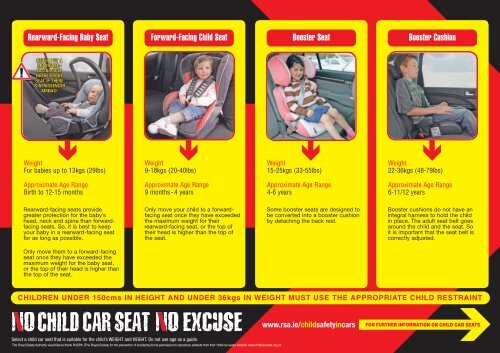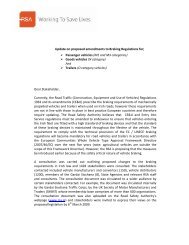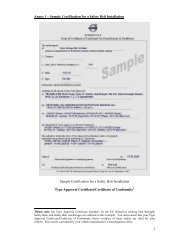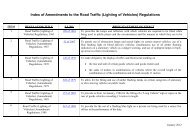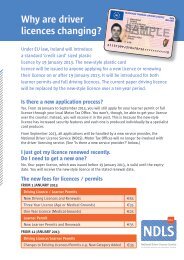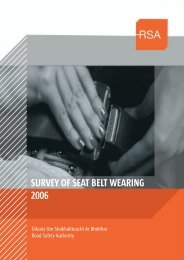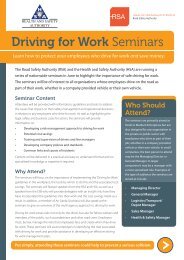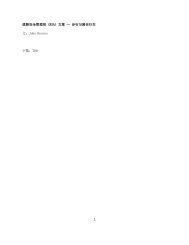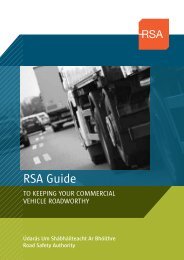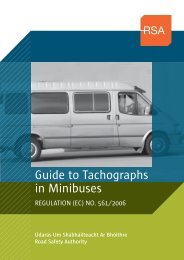Child seat-weight chart (pdf) - Road Safety Authority
Child seat-weight chart (pdf) - Road Safety Authority
Child seat-weight chart (pdf) - Road Safety Authority
Create successful ePaper yourself
Turn your PDF publications into a flip-book with our unique Google optimized e-Paper software.
Rearward-Facing Baby Seat<br />
Forward-Facing <strong>Child</strong> Seat<br />
Booster Seat<br />
Booster Cushion<br />
NEVER PUT A<br />
REARWARD-<br />
FACING SEAT<br />
IN THE FRONT<br />
SEAT IF THERE<br />
IS A PASSENGER<br />
AIRBAG!<br />
Weight<br />
For babies up to 13kgs (29lbs)<br />
Weight<br />
9-18kgs (20-40lbs)<br />
Weight<br />
15-25kgs (33-55lbs)<br />
Weight<br />
22-36kgs (48-79lbs)<br />
Approximate Age Range<br />
Birth to 12-15 months<br />
Approximate Age Range<br />
9 months - 4 years<br />
Approximate Age Range<br />
4-6 years<br />
Approximate Age Range<br />
6-11/12 years<br />
Rearward-facing <strong>seat</strong>s provide<br />
greater protection for the baby’s<br />
head, neck and spine than forwardfacing<br />
<strong>seat</strong>s. So, it is best to keep<br />
your baby in a rearward-facing <strong>seat</strong><br />
for as long as possible.<br />
Only move your child to a forwardfacing<br />
<strong>seat</strong> once they have exceeded<br />
the maximum <strong>weight</strong> for their<br />
rearward-facing <strong>seat</strong>, or the top of<br />
their head is higher than the top of<br />
the <strong>seat</strong>.<br />
Some booster <strong>seat</strong>s are designed to<br />
be converted into a booster cushion<br />
by detaching the back rest.<br />
Booster cushions do not have an<br />
integral harness to hold the child<br />
in place. The adult <strong>seat</strong> belt goes<br />
around the child and the <strong>seat</strong>. So<br />
it is important that the <strong>seat</strong> belt is<br />
correctly adjusted.<br />
Only move them to a forward-facing<br />
<strong>seat</strong> once they have exceeded the<br />
maximum <strong>weight</strong> for the baby <strong>seat</strong>,<br />
or the top of their head is higher than<br />
the top of the <strong>seat</strong>.<br />
CHILDREN UNDER 150cms IN HEIGHT AND UNDER 36kgs IN WEIGHT MUST USE THE APPROPRIATE CHILD RESTRAINT<br />
The <strong>Road</strong> <strong>Safety</strong> <strong>Authority</strong> would like to thank RoSPA ( The Royal Society for the Prevention of Accidents ) for its permission to reproduce extracts from their ‘child car <strong>seat</strong>s’ website www.childcar<strong>seat</strong>s.org.uk<br />
CHILDCAR SEAT<br />
EXCUSE<br />
www.rsa.ie/childsafetyincars<br />
FOR FURTHER INFORMATION ON CHILD CAR SEATS<br />
Select a child car <strong>seat</strong> that is suitable for the child’s WEIGHT and HEIGHT. Do not use age as a guide.<br />
The <strong>Road</strong> <strong>Safety</strong> <strong>Authority</strong> would like to thank RoSPA (The Royal Society for the prevention of Accidents) for its permission to reproduce extracts from their ‘child car <strong>seat</strong>s’ website www.childcar<strong>seat</strong>s.org.uk
www.rsa.ie/childsafetyincars<br />
KNOW THE NEW LAW LAW<br />
KNOW THENEW LAW LAW ONFOR CHILD CHILD CAR CARSEATS<br />
on child car <strong>seat</strong>s<br />
EXCUSE<br />
CHILDCAR SEAT<br />
EU Newchild EU child safety safety protection laws laws have come into force<br />
making it compulsory for all children to travel in the<br />
correct child <strong>seat</strong>, booster <strong>seat</strong> or booster cushion<br />
Where safety belts have been fitted they must be worn<br />
<strong>Child</strong>ren under 3 years of age must not travel in a car or goods<br />
vehicle (other than a taxi) unless restrained in the correct child <strong>seat</strong><br />
<strong>Child</strong>ren aged 3 years or over who are under 150cms in height and<br />
weighing less than 36 36 kilograms (i.e. (i.e generally children up up to to 11/12<br />
years old) must use the correct child <strong>seat</strong>, booster <strong>seat</strong> or or booster<br />
cushion when travelling in cars or goods vehicles<br />
FURTHER INFORMATION ON CHILD CAR SEATS<br />
Learn more about child car <strong>seat</strong>s by<br />
visiting www.rsa.ie/childsafetyincars,<br />
reading the ‘CHILD SAFETY IN CARS’<br />
booklet or watching the ‘CHILD<br />
SAFETY IN CARS’ DVD.<br />
Both the booklet and DVD are<br />
available FREE to order online at<br />
www.rsa.ie/childsafetyincars or by<br />
telephone LoCall 1890 50 60 80.<br />
<strong>Child</strong>ren over 3 years of age must travel in a rear <strong>seat</strong> in vehicles<br />
not fitted with safety belts<br />
Rearward-facing child car <strong>seat</strong>s must NEVER be used in the front<br />
passenger <strong>seat</strong> of cars with an active airbag<br />
<strong>Child</strong> car <strong>seat</strong>s must be in accordance with EU or United Nations-<br />
Economic Commission for Europe (UN-ECE) standards<br />
Drivers have a legal responsibility to ensure passengers aged under<br />
17 use the correct <strong>seat</strong>, booster <strong>seat</strong>, booster cushion or <strong>seat</strong>belt<br />
Ensuring a child is properly restrained in a child car <strong>seat</strong> can reduce injuries<br />
by a factor of 90-95% for rear-facing <strong>seat</strong>s and 60% for forward-facing <strong>seat</strong>s*.<br />
*Source: AA Motoring Trust<br />
Booklet<br />
DVD<br />
www.rsa.ie/childsafetyincars<br />
www.rsa.ie/childsafetyincars<br />
ILLUSTRATED GUIDE TO CHILD CAR SEATS


